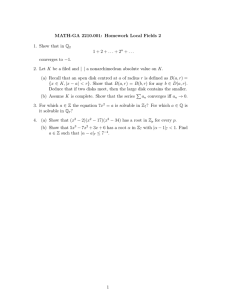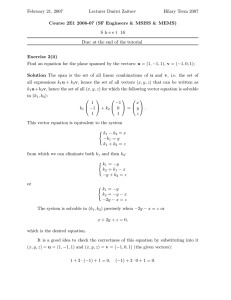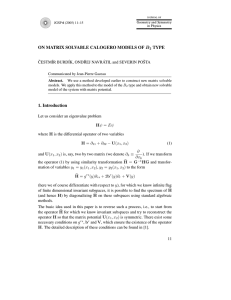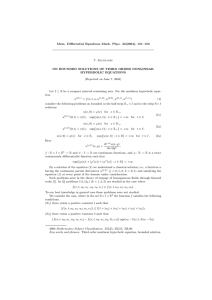Some Residually Solvable One-Relator Groups
advertisement
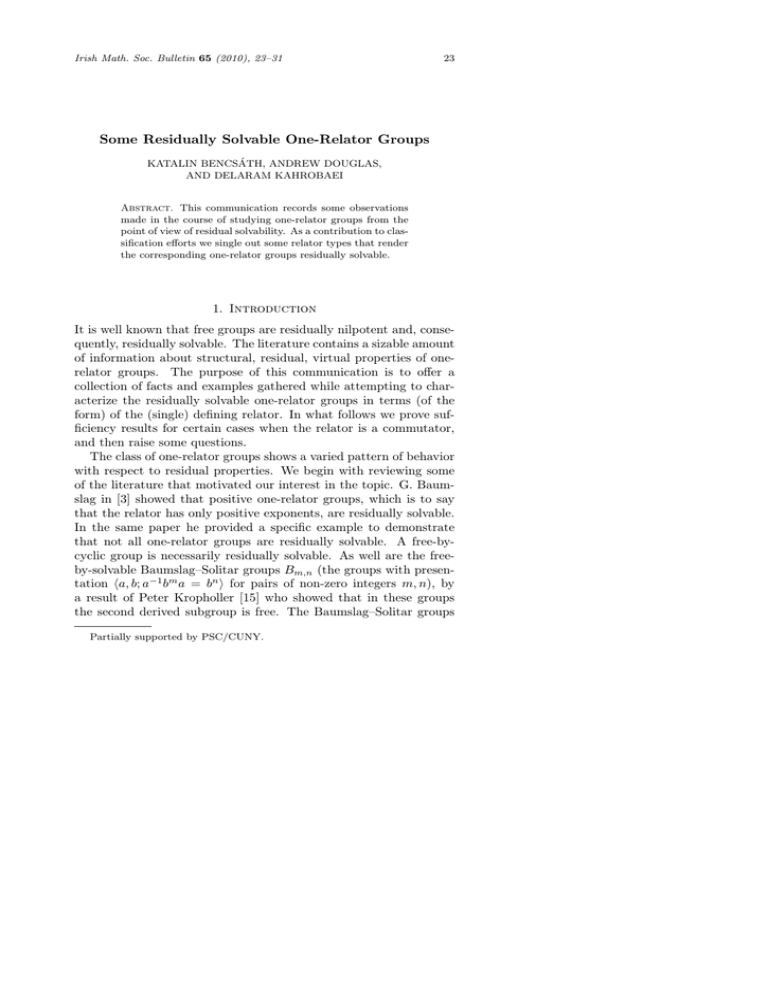
Irish Math. Soc. Bulletin 65 (2010), 23–31
23
Some Residually Solvable One-Relator Groups
KATALIN BENCSÁTH, ANDREW DOUGLAS,
AND DELARAM KAHROBAEI
Abstract. This communication records some observations
made in the course of studying one-relator groups from the
point of view of residual solvability. As a contribution to classification efforts we single out some relator types that render
the corresponding one-relator groups residually solvable.
1. Introduction
It is well known that free groups are residually nilpotent and, consequently, residually solvable. The literature contains a sizable amount
of information about structural, residual, virtual properties of onerelator groups. The purpose of this communication is to offer a
collection of facts and examples gathered while attempting to characterize the residually solvable one-relator groups in terms (of the
form) of the (single) defining relator. In what follows we prove sufficiency results for certain cases when the relator is a commutator,
and then raise some questions.
The class of one-relator groups shows a varied pattern of behavior
with respect to residual properties. We begin with reviewing some
of the literature that motivated our interest in the topic. G. Baumslag in [3] showed that positive one-relator groups, which is to say
that the relator has only positive exponents, are residually solvable.
In the same paper he provided a specific example to demonstrate
that not all one-relator groups are residually solvable. A free-bycyclic group is necessarily residually solvable. As well are the freeby-solvable Baumslag–Solitar groups Bm,n (the groups with presentation ha, b; a−1 bm a = bn i for pairs of non-zero integers m, n), by
a result of Peter Kropholler [15] who showed that in these groups
the second derived subgroup is free. The Baumslag–Solitar groups
Partially supported by PSC/CUNY.
24
K. Bencsáth, A. Douglas and D. Kahrobaei
B1,n (n 6= 0 integer) are solvable but not polycyclic; and the nonHopfian (therefore not residually finite) Baumslag–Solitar groups are
not residually nilpotent.
It is worth mentioning here that a large class of residually solvable
one-relator groups is indicated by [8]: G. Baumslag, Fine, Miller and
Troeger established that many one-relator groups, in particular cyclically pinched one-relator groups, are either free-by-cyclic or virtually
free-by-cyclic. Further, a recent result of M. Sapir and I. Spakulova
in [17] tells that, with probability (measured in terms of the length
of the relator) tending to 1, a one-relator group with at least 3 generators is residually finite, even virtually a residually (finite p)-group,
and coherent, for all sufficiently large primes p. In his subsequent
work [16] M. Sapir also focuses on residual properties of one-relator
groups with at least 3 generators. Our attention is turned mainly
toward two-generator one-relator groups.
Our two main results concern the situation where G is a onerelator group whose relator is a commutator. First we recall, in fair
detail, some classes of one-relator groups whose behavior with regard
to residual solvability has been established before. Then we show sufficiency, for residual solvability, of certain conditions imposed on the
(single) defining relator of the one-relator group. Then, we provide
examples illustrating the difficulty in determining residual solvability
of one-relator groups with arbitrary commutator.
Clearly, attempts to find criteria for residual solvability could
be facilitated by linkages to outcomes of recent and older studies
on the (fully) residually freeness of one-relator groups, in particular. For example, surface groups are easily found residually solvable
since they are known to be fully residually free [6]. Also, in [2]
B. Baumslag shows residual freeness for one-relator groups of the
type ha1 , · · · , ak ; a1 w1 · · · ak wk = 1i, where k > 3, and the wi ’s in
the ambient free group on a1 , · · · , ak satisfy certain conditions; thus
residual solvability for such one-relator groups is immediate.
2. Preliminaries
For convenience, we start with a list of some of the definitions, facts,
and theorems we will rely on throughout.
Theorem 2.1 (Von Dyck). Suppose G = hX; Ri and D = hX; R ∪
Si, with presentation maps γ and µ respectively. Then xµ 7→ xγ
(x ∈ X) defines a homomorphism of G onto D.
Some Residually Solvable One-Relator Groups
25
Theorem 2.2 (Freiheitssatz, [14]). Let G be a one-relator group,
i.e., G = hx1 , · · · , xq ; r = 1i. Suppose that the relator r is cyclically
reduced, i.e., the first and the last letters in r are not (formal) inverses of each other. If each of x1 , · · · , xq actually appears in r, then
any proper subset of {x1 , · · · , xq } is a free basis for a free subgroup
of G.
W. Magnus’ method of structure analysis [14] for groups with a
single defining relation has the following immediate consequence:
Lemma 2.3. Let G = hb, x, · · · , c; r = 1i be a one-relator group.
Suppose that b occurs in r with exponent sum zero and that upon reexpressing r in terms of the conjugates bi xb−i = xi , · · · , bi cb−i = ci
(i ∈ Z) and renaming r as r0 , µ and ν are respectively the minimum
and maximum subscripts of x occurring in r0 . If µ < ν and if both
xµ and xν occur only once in r0 then N = gpG (x, · · · , c) is free. If
G is a two-generator group with generators b and x, then N is free
of rank ν − µ + 1.
Definition 2.4. A group G is residually solvable if for each w ∈ G
(w 6= 1), there exists a solvable group S = S(w) and an epimorphism
φ : G −→ S such that wφ 6= 1.
Theorem 2.5 (Kahrobaei, [12], [13]). Any generalized free product
of two finitely generated torsion-free nilpotent groups, amalgamating
a cyclic subgroup, is an extension of a residually solvable group by a
solvable group. It is therefore residually solvable.
Theorem 2.6 (Kahrobaei, [12], [13]). Any generalized free product of an arbitrary number of finitely generated nilpotent groups of
bounded class, amalgamating a subgroup central in each of the factors, is an extension of a free group by a nilpotent group. It is therefore residually solvable.
Theorem 2.7 (Kahrobaei, [12], [13]). The generalized free product of a finitely generated torsion-free abelian group and a nilpotent group is (residually solvable)-by-abelian-by-(finite abelian), consequently residually solvable.
Note that the groups in all three of these theorems above satisfy
the conditions of K. Gruenberg’s portent observation [10] that we
record here as
Lemma 2.8. Suppose P is any group, K C P with P/K solvable
and K residually solvable. Then P is residually solvable.
26
K. Bencsáth, A. Douglas and D. Kahrobaei
3. The Single Relator is a Commutator
We first recall a result from [4] for a particular class of non-positive
one-relator groups. Let G be a group that can be presented in the
form,
G = ht, a, ..., c; uw−1 = 1i,
(1)
where u and w are positive words in the given generators and each
generator occurs with exponent sum zero in uw−1 . Then G is residually solvable. In fact, G is free-by-cyclic.
Now consider the group
H = ht, a, ..., c; [u, w] = 1i.
(2)
If u and w are positive, H can be recognized as one of the groups
in the preceding class (1). Hence H is free-by-cyclic and therefore
residually solvable. However, known examples show that residual
solvability for H is not guaranteed once the requirement that both
u or w be positive is relaxed:
Example 3.1. [4] If G = ha, b, ..., c; [u, v] = 1i, where
u = a, v = [a, b][w, wb ], and w = [a, b]−1 [a, b]a ,
then G is not residually solvable.
Proof. It follows from Magnus’ solution of the word problem that
w 6= 1 in G [14]. Since [u, v] = 1, we find that
[a, b]a [w, wb ]a = [a, b][w, wb ],
so that
w = [a, b]−1 [a, b]a = [w, wb ]([w, wb ]a )−1 .
Thus w lies in every term of the derived series of G.
In contrast, the next example is a residually solvable one-relator
group.
Example 3.2. The group G = ha, b; [a, [a, b]]i is free-by-cyclic.
Proof. We expand and re-express the relator,
r = [a, [a, b]] = a−1 [a, b]−1 a[a, b] = a−1 b−1 a−1 bab−1 ab.
(3)
Observe that in
−1
r0 = b−1
1 b2 b1 b0
µ = 2, ν = 0, b0 and b2 both occur only once, so we can invoke
Lemma 2.3. Therefore G, as a cyclic extension of the free group
N = gpG (b), is residually solvable (cf. 2.8).
Some Residually Solvable One-Relator Groups
27
4. Connection between Generalized Free Products and
One-Relator Groups
Over the years since W. Magnus developed his treatment of onerelator groups the increased interest in them yielded many new results. Karrass and Solitar in 1971 showed that a subgroup of a
one-relator group is either solvable or contains a free subgroup of
rank two. G. Baumslag and Shalen showed that every one-relator
group with at least four generators can be decomposed into a generalized free product of two groups where the amalgamated subgroup is
proper in one factor and of infinite index in the other. Fine, Howie
and Rosenberger [7], and Culler and Morgan [9] showed that any
one-relator group with torsion and at least three generators can be
decomposed, in a non-trivial way, as an amalgamated free product.
These results made it seem reasonable to expect that a closer look
at the residual solvability of generalized free products of two groups
could provide further tools for detection of residual solvability of
one-relator groups. The following result confirms that assumption.
Theorem 4.1. The group G = ha, b; [a, w]i, where w = [a, b]n (n ∈
N), is residually solvable.
Proof. Put N = gpG (b), the normal closure of b in G. Using the
Magnus break-down, we consider:
n
N0 = hb0 , b1 , b2 ; (b1 b0 )n = (b−1
2 b1 ) i.
(4)
Now let
−1
x0 = b−1
1 b0 , x1 = b2 b1 , y = b1 .
Tietze transformations confirm that
N0 = hx0 , x1 , y; (x0 )n = (x1 )n i = hx0 , x1 ; (x0 )n = (x1 )n i ∗ hyi. (5)
Next let K = hx0 , x1 ; (x0 )n = (x1 )n i. Clearly
K = {hx0 i ∗ hx1 i; hxn0 i = hxn1 i}
(6)
Since each factor of K is abelian, by Theorem 2.5 K is residually solvable. The free factor of N0 , hyi is also residually solvable. Therefore
N0 is residually solvable, and it follows for every i ∈ N that Ni is
residually solvable. If we put Ni,j = gp(Ni , Ni+1 , ..., Nj ), the preceding approach gives
Ni,j = hxi i ∗hxni i=hxni+1 i ∗hxi+1 i ∗ · · · ∗ hxj i ∗hxnj i=hxnj+1 i ∗hxj+1 i ∗ hyi.
28
K. Bencsáth, A. Douglas and D. Kahrobaei
Therefore, by Theorem 2.6, Ni,j is residually solvable. A task
that remains for completing the proof is to show that the ascending
union N = ∪r<0;s>0 Nr,s is residually solvable, which will be taken
care of by the following Proposition 4.2. Granted that, the residual
solvability of G follows with the use of Corollary 2.8.
Proposition 4.2. N = ∪r<0;s>0 Nr,s is residually solvable.
Proof. We will retain notation from the proof of Theorem 4.1 and
start with the assumption that Ni,j is residually solvable for all i, j ∈
N (i ≤ j). For the derived series of N = ∪r<0;s>0 Nr,s , we have
δi N = δi (∪r<0;s>0 Nr,s ).
Every element g ∈ δi N is a finite product of commutators of elements
from a (finite) subset of the Nr,s groups. So g ∈ δi Nr,s for suitably
small value of r < 0 and suitably large value of s > 0. Thus δi N =
∪r<0;s>0 Nr,s . Now, if j, k are a pair of fixed integers the infinite
union above can be rewritten as
δi N = ∪r<0;s>0 δi Nj+r,k+s ,
so that,
δi N ∩ Nj,k = (∪r<0;s>0 δi Nj+r,k+s ) ∩ Nj,k .
Equivalently,
δi N ∩ Nj,k = ∪r<0;s>0 (δi Nj+r,k+s ∩ Nj,k ).
Further, each term in the union can be written as
δi Nj+r,k+s ∩ Nj,k = (δi Nj,k+s ∩ Nj,k ) ∩ (δi Nj+r,k ∩ Nj,k ).
And because s < 0 and r > 0, an argument fashioned after that in
[3, p. 175, Lemma 4.3] yields after suitable conjugations that
δi Nj,k+s ∩ Nj,k = δi Nj,k and
δi Nj+r,k ∩ Nj,k = δi Nj,k .
So each term in the union can be re-expressed as
δi Nj+r,k+s ∩ Nj,k = δi Nj,k .
Notice that this expression is independent of r and s. Thus, we get
δi N ∩ Nj,k = δi Nj,k ([3, pg. 175, line 16]).
We claim that
δi N ∩ Nj,k = δi Nj,k
Some Residually Solvable One-Relator Groups
29
implies that N is residually solvable. To see this, let g be a nontrivial element of
N = ∪r<0;s>0 Nr,s .
Then there is an integer j = j(g) ∈ N such that g ∈ N−j,j . By
our (inductive) hypothesis at the outset N−j,j is residually solvable.
Consequently, there exists an integer i ∈ N such that g ∈
/ δi N−j,j .
Then, since δi N ∪ N−j,j = δi N−j,j , we see that g ∈
/ δi N ∩ N−j,j .
But g ∈ N−j,j . So it must be the case that g ∈
/ δi N . Thus we have
found a normal subgroup δi N C N with the property that g ∈
/ δi N
and N/δi N is solvable. Hence N is residually solvable.
5. The Relator is a Basic Commutator
The tools of the Magnus theory were of good use for proving residual
solvability through gaining information about the structure of the
two-generator one-relator groups where the relator is a particular
type of basic commutator.
We begin with recalling P. Hall’s [11] definition of the basic commutators (in terms of the free group F on {x1 , ..., xq }) and their
linear ordering (in terms of their weights).
Definition 5.1. Basic Commutators.
(1) The basic commutators of weight one with their linear order are x1 < x2 < · · · < xq ; for their weights we write
wt(xi ) = 1.
(2) Having defined the basic commutators of weight less than
n, the basic commutators with weight n are of the form
cn = [ci , cj ] where ci and cj are all the basic commutators
satisfying wt(ci ) + wt(cj ) = n, ci > cj , and such that if
ci = [cs , ct ], then cj ≥ ct .
In the following we will use the notation s1 = x and sk+1 = [sk , y]
for positive integers k.
Theorem 5.2. The group G = hx, y; r = [sk , y]i is free-by-cyclic,
therefore residually solvable.
Proof. Following the Magnus theory we put xi = y −i xy i for this two
generator case. Using induction on the weight of the commutator
and the relationship
y
[sk , y] = s−1
k (sk ) (k > 0),
30
K. Bencsáth, A. Douglas and D. Kahrobaei
we see that the minimum index and maximum index in r0 are 0 and
k, respectively, and both of x0 and xk occur only once in r0 . By
Lemma 2.3 it follows, similarly to previous cases, that G is free-bycyclic.
6. Open Problems
(1) Is it algorithmically decidable whether a one-relator group is
residually solvable?
(2) Are one-relator groups generically residually solvable? In other
word, are they in most cases residually solvable? I. Kapovich conjectured [5] that many one-relator groups are finitely generated freeby-cyclic.
(3) Do there exist residually finite one-relator groups that are not
residually solvable? (This is recasting a question in [1] in this context.)
(4) As defining relators, certain basic commutators were shown in
this paper to render the respective one-relator groups residually solvable. Would all basic commutators have that property? If not, can
the techniques used here be extended to one-relator groups with further types of basic commutator for their defining relator?
(5) Find further examples of non-positive one relator groups that
fail to be residually solvable.
(6) Find examples of residually solvable one-relator groups that are
not free-by-cyclic.
References
[1] G. Arzhantseva, P. de la Harpe, D. Kahrobaei, Z. Sunik, The true prosoluble
completion of a group: Examples and open problems, Journal of Geometriae
Dedicata, Springer Netherlands 124 (2007) No.1, 5–26.
[2] B. Baumslag, Residually free groups, Proc. London Math. Soc. (3) 17 (1967)
402–18.
[3] G. Baumslag, Positive one-relator groups, Trans. Amer. Math. Soc. 156
(1971), 165–183.
[4] G. Baumslag, Free subgroups of certain one-relator groups defined by positive words, Math. Proc. Cambridge Phil. Soc. 93 (1983), 247–251.
[5] O. Bogopolski, A. Martino, O. Maslakova, and E. Ventura, The conjugacy
problem is solvable in free-by-cyclic groups, Bull. London Math. Soc. 38
(2006), 787–794.
[6] C. Champetier, V. Guirardel, Limit groups as limits of free groups, Israel
J. Math. 146 (2005), 1–75.
[7] B. Fine, J. Howie, G. Rosenberger, One-relator quotients and free products
of cyclics, Proc. Amer. Math. Soc. 102 (1988), 249–254.
Some Residually Solvable One-Relator Groups
31
[8] G. Baumslag, B. Fine, C.F. Miller, and D. Troeger, Virtual properties of
cyclically pinched one-relator groups, Int. J. Algebra and Computation 19
(2009), 213–227.
[9] M. Culler, J. Morgan, Group actions on R-trees, Proc. London Math. Soc.
(3) 55 (1987), 571–604.
[10] K.W. Gruenberg, Residual Properties of Infinite Soluble Groups, Proc. London Math. Soc. (3) 7 (1957), 29–62.
[11] M. Hall, The theory of groups. Chelsea Publishing Company, 1976.
[12] D. Kahrobaei, Residual solvability of generalized free products, The City
University of New York (GC) PhD Thesis, October 2004.
[13] D. Kahrobaei, On residual solvability of generalized free products of finitely
generated nilpotent groups, Comm. in Algebra, to appear.
[14] W. Magnus, A. Karrass, and D. Solitar, Combinatorial group theory, Dover,
1975.
[15] P. H. Kropholler, Baumslag-Solitar groups and some other groups of cohomological dimension two, Comment. Math. 65 (1990), 547-558.
[16] M. Sapir, Residual properties of 1-relator groups arXiv:1001.2829, (2010).
[17] M. Sapir, I. Spakulova, Almost all one-relator groups with at least three
generators are residually finite. arXiv:0809.4693 (2009).
Katalin Bencsáth,
Department of Mathematics and Computer Science,
Manhattan College,
Riverdale, New York 10471, USA
katalin.bencsath@manhattan.edu
Andrew Douglas,
Department of Mathematics,
New York City College of Technology, CUNY,
300 Jay Street, Brooklyn,
New York 11201, USA
adouglas@citytech.cuny.edu
Delaram Kahrobaei,
Doctoral Program in Computer Science Department,
CUNY Graduate Center, City University of New York,
365 Fifth Ave.,
New York 10016, USA
dkahrobaei@gc.cuny.edu
Received on 30 April 2010.

